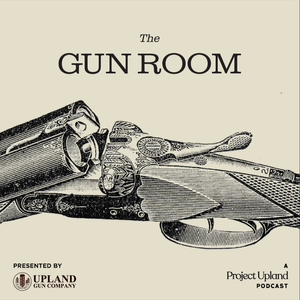
The Gun Room
Northwoods Collective
All episodes
Best episodes
Seasons
Top 10 The Gun Room Episodes
Goodpods has curated a list of the 10 best The Gun Room episodes, ranked by the number of listens and likes each episode have garnered from our listeners. If you are listening to The Gun Room for the first time, there's no better place to start than with one of these standout episodes. If you are a fan of the show, vote for your favorite The Gun Room episode by adding your comments to the episode page.

The Gun Room: Episode 35
The Gun Room
05/20/22 • 80 min
In this episode of The Gun Room, Joel talks with Brian Dudley of BMD Gunstocks. They talk about Brian's fine art background and how he transitioned into firearms full-time. The conversation covers a variety of topics related to stock making including original finishes, shaping, and finishing stocks including a good conversation about stock checkering.

TGR: Episode 36, Diggory Hadoke
The Gun Room
06/10/22 • 81 min
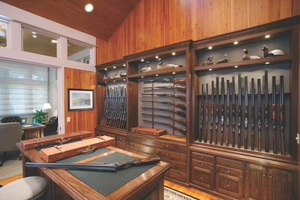
The Gun Room: Episode 32
The Gun Room
04/22/22 • 58 min
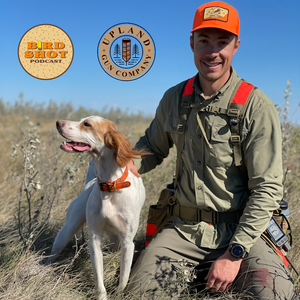
The Gun Room: Episode 34
The Gun Room
05/06/22 • 66 min
Part 2 of a discussion with Nick Larson of The Birdshot Podcast. Nick and Joel talk about Nick's turkey gun project and the jitters surrounding drilling into your gunstock. The discussion moves into progress and updates from the Upland Gun Company where we talk about their new offerings and the process of creating your own upland shotgun.
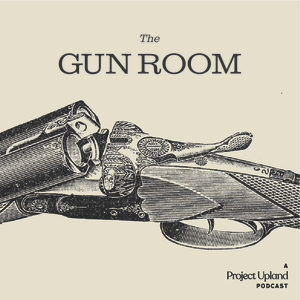
The Gun Room: Episode 30
The Gun Room
11/12/21 • 66 min
Join us for a conversation with Amanda Rutherford of Zeb gunmaking. Amanda attended gunsmithing school in Colorado where a fortuitous trip to the Dallas Safari Club show led to an apprenticeship with Chuck Grace as a stockmaker. Amanda and I discuss some of the finer points of the master/apprentice relationship, the value of gunsmithing school, and her journey to becoming a gun maker on her own. We also touch on some of her custom gun work and run-ins with some legendary gunmakers. This and so much more on Episode 30 of The Gun Room. https://www.zebgunmaking.com/
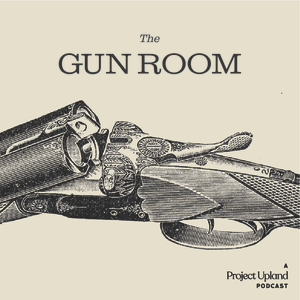
The Gun Room: Episode 28
The Gun Room
10/01/21 • 10 min
One of the most common things folks do when inspecting a potential shotgun purchase is shoulder the gun. It seems an interesting thing that ‘gun mount’ is such a crucial part of the gun purchase, but so many folks simply shoulder a gun and assign a non-quantitative value to it: “oh this shoulders nice” or “feels right”. So many of those folks realize that a gun must ‘fit’ but very few actually know or understand their own dimensions and how they translate to a gunstock. The same holds true for backyard clays shooting when you try a new-to-you shotgun that seems to break everything you point it at. In those situations gun fit and by association stock dimensions are the heart of the matter. Im Joel Penkala and this is 10 Minutes on Gun Fit.
The most basic of gunstock dimensions and one that is actually addressed by some gun companies is the Length of Pull or LOP(as it appears on many online gun listings). The length of pull is the distance from the center of the trigger, rearward to the center of the butt plate or pad. This is also expounded upon at times with three different LOP measures: LOP to the heel, center, and toe. The comb is the top of the stock, where your cheek rests which terminates at the heel, while the toe is the bottom portion of the end of the stock. It is typically tapered and comes to a point. LOP to the center determines the primary contact between shooter and buttstock, but the heel and toe measures give an idea of the stock’s pitch.
Pitch is the angle between a line defined by the rib (and/or comb) and the line defined by the butt(given that the butt is not curved). If you imagine laying the long leg of a square on the rib, the 90-degree angle defined by the square would be pitch. This angle can obviously be greater or less than 90 depending on the shooter’s preference or the gun’s intended use. Typically pitch is adjusted for guns that will shoot driven birds; all overhead shooting where the gun is pointed primarily up, vs rough shooting where shots are out in front of the shooter. Pitch can also be adjusted so that the toe of the shotgun does not dig into a shooter’s chest. Shooters with fuller chest dimensions will oft times complain about this digging of the toe.
LOP is important because it determines the geometry of the shooter’s arms. A short LOP will ‘chicken-wing’ your arms; the angle at your elbows being very acute. A long LOP will open up the angle of your arms and in extreme cases even straighten out the arms. The goal here is to adjust the LOP to create a proper geometry between the shooter and the shotgun or rifle in question. There is of course a sweet spot where the shooter’s arms are comfortable and provide the most stable and controlled connection between the gun and body.
LOP is addressed by companies like Rizzini and others who typically include a basic thin wooden or black butt plate with their guns. The idea behind this is that they leave as much stock wood as possible by only adding a thin pad. Then the shooter can add a 1” or larger recoil pad to increase LOP or cut the stock down and add a pad to decrease LOP. Other instances like youth guns for example typically have shorter LOP to fit youth shooters.
Two other primary stock dimensions are drop and cast. Drop addresses the relation of the comb to the rib up and down, where cast determines the relation of the comb and rib left to right. Drop on a stock comes in two (sometimes three) measures, and they are usually listed in order from the nose or most forward part of the comb to the heel. The measurement is actually the distance from the line defined by the rib (and parallel to the bores), to the spot on the comb being measured. One can get rough dimensions of drop by placing a shotgun upside down on its barrels(and thus the rib) and taking the measure from the comb to the tabletop. These measures are complicated by Monte Carlo stocks with elevated cheek pieces, which sometimes have drop measures for each end of the raised cheek or Monte Carlo piece, as this is where the shooter’s cheek contacts the stock and in effect is the important factor in drop. Proper drop will position the shooter’s eye in line with the rib. Too much drop and your eye will be below the barrels and when your face is properly against the stock, you will be looking at the breech of the gun. Too little drop and you will be looking down at the rib, seeing the entire length of it while shooting.
Too much drop requires the shooter to lift their cheek off the stock to appropriately sight down the rib. Though this can be done, it is no longer in vogue. The old style of head-held high shooting has gone by the wayside as folks have moved into more modern styles dictated by sporting clays and other shotgun sports, though this old shooting is immortalized by our favorite shooting artists in many of their classic pieces. Too little drop is very hard to adjust for because you can’t ever get your eye pr...
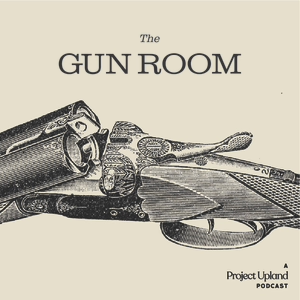
The Gun Room: Episode 26
The Gun Room
09/17/21 • 9 min
It is, at times, easy to take for granted the complexity of manufacturing involved in creating a fine sporting rifle or shotgun. As hunters or shooters, finding a gun that fits, breaks clays or hits birds is foremost in our mind. As we dive into and explore the construction of modern guns, we quickly begin to see a great diversity of techniques developed over the last 200 years or so that illustrate just how much thought has been put into the construction of the shotguns or rifles we love. Im Joel Penkala and this is 10 Minutes on Double Gun Barrels
With the exception of double rifles, which fall into the larger category of ‘double guns’ a vast majority of modern rifle barrels are fitted to their actions via barrel threads. The threaded barrel is similar to a screw that threads into the same pitch threads in the action. A gunsmith will painstakingly cut these threads until proper headspace, or fit between action, bolt, and barrel is achieved.
Double guns are in general manufactured differently, although there are always exceptions. Break action doubles like your Beretta 686, Parker, or Holland and Holland double rifle all have barrels that have been joined together without threading a barrel.
In terms of geometry, if we think about any gun with two barrels, it may be a first intuition to think that the bores are parallel; perfect to one another. This is in fact not the case. For both double rifles and shotguns, the barrels are laid such that the trajectory of the bores crosses downrange at some specified distance. This convergence allows a single targeting sight plane to function for both barrels. In terms of double rifles, this is exceptionally important, and ‘regulation’ of these guns is perhaps one of the most mythological and mystifying procedures I have heard folks speak about in the gun world. There are very few folks in the states that will even take on the task of regulating a double rifle, the process of ensuring a proper cross at a specific distance with particular ammunition(side by side or over/under).
Needless to say, joining double gun barrels happens in two ways, but terminology first. The breech end of the barrels is commonly called the breech bloc or lump, though the ‘lump’ or ‘lumps’ may refer to individual surfaces that lock an action shut. What I will refer to as the lump or breech bloc contains the lockup surfaces, ejectors/extractor channels, the breech face, and all associated elements. The lump can be created from a single solid piece of steel without barrels connected. Barrels are added after machining the lump by sleeving and braising. Or the lump is formed during the joining process. That is to say that each barrel contains a block of metal on the breech end of the barrel half the size of the lump. Those blocks of steel mate together when two barrels are joined and thus the lump is formed. In this case, the lump is machined after the barrels are joined together. In some cases, the barrels are separate pieces and a third piece is joined to create the lump illustrating the diversity of manufacturing possibilities.
Mono-bloc barrels are formed by machining the chamber portion or lump from a single solid piece of steel and take advantage of modern precision engineering and manufacturing techniques. The biggest advantage is allowing the complex (and very co-dependent) angles to be machined into the action with a high degree of accuracy. The final fitting required on a mono-bloc gun is typically less than others. These guns can usually be produced with less final hand fitting making them less costly.
There are two styles of joining barrels that utilize full-length single-piece barrel + lump construction. Demi-bloc and chopper lump barrels both involve joining two halves of the barrels, top and bottom for an O/U and each side for the side x side, to make the barrel set. Demi-bloc barrels utilize a male/female dovetail to mate the two barrel halves. Chopper lump barrels simply mate two flat surfaces in the action end of the barrels to form the lump. Shoe lump or through lump barrels are a third option where two full-length barrels are joined with a third machined piece that contains the ‘lump’ or ‘lumps’. Demi-bloc and chopper lump barrels are oft times confused with one another and a host of marketing folks has helped to confuse the topic more by calling one the other and so forth.
When considering the pros and cons of each of the above, it is commonly accepted that Demi-bloc barrels are the strongest being made of only two full-length pieces and joined by a dovetail. Chopper lump barrels were developed heavily in British guns and produce the thinnest and lightest barrels while maintaining strength. They are also the most time-consuming and difficult to produce but considered the finest in construction. Through lump are common in American classic doubles that we all know and love, thought this and shoe lumps generally tend to be w...
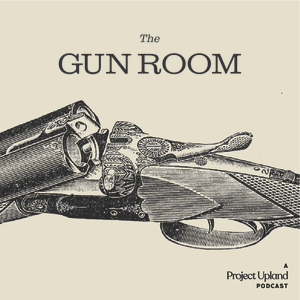
The Gun Room: Episode 5
The Gun Room
04/24/21 • 47 min
On location in Sanford, North Carolina at the Southern Side by Side. Hosted at Deep River Sporting Clays, a weekend of side by side guns, comradery and clays shooting. We sit down with Art Wheaton whose career spans decades at Remington to talk about Big Green, The Parker Gun Collectors Association, and the Remington 870.

The Gun Room: Episode 15
The Gun Room
07/02/21 • 67 min
Join me this week as we sit down with Grace Callahan, professional woman’s sporting clays shooter and coach. Grace has been shooting clays from the early age of 10 and with the support of her family and some friendly folks along the way has risen to become one of the top clays shooters in the country. Grace currently shoots for Caesar Guerini and Syren. She has made a name for herself on the NSCA circuit, frequently ranking in the open divisions. We discuss the details of what it takes to go pro, target setting, clays shooting games, and more on this episode of The Gun Room.
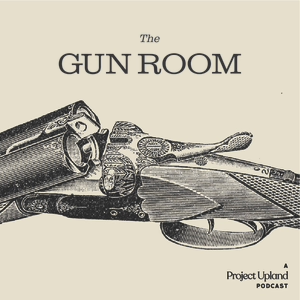
The Gun Room: Episode 29
The Gun Room
10/08/21 • 12 min
Barrel Proofing
Dad and I were browsing the used gun rack at a big box store on a trip through Pennsylvania a few years back when we happened upon a double gun that caught our eye. The gun was a 12ga with light color walnut stock and forend. On closer inspection, we saw a moderate amount of hand-cut engraving, as well as hand-cut checkering on the buttery walnut stock. An older gun made in Europe, the tag read ‘BLNE’, as it is sometimes referred to in gun parlance or a boxlock non-ejector. We speculated on the country of origins and details of the gun’s specifications until we could get the attention of one of the clerks to ask if it was OK to take the barrels off the action and check the proof marks.
Spend any amount of time in a gun shop that deals with guns from Europe and you will inevitably hear someone say “check the proof marks”. This statement broadly suggests checking the markings on the barrel flats and action watertable(on a shotgun). These are the two areas that gunmakers typically apply stampings pertaining to original specifications of the gun like chamber length or choke. It is also the area where proof houses apply proof marks on a gun.
Proofing is a type of (potentially) destructive testing whereby a firearm is discharged with appropriate dimension ammunition that has been overloaded with powder on purpose. Shooting a round overcharged with powder produces higher than normal pressure inside the barrels and action when the gun is fired. If the gun can withstand the increased pressure produced by an ‘overloaded’ round, it will withstand the significantly lower pressure of standard factory ammunition. Guns are measured before and after testing and fired remotely while being held in fixtures inside secured rooms for safety reasons. Proofing is a pass or fail test, there is no middle ground. Guns that fail may experience a bulged or split barrel, or in extreme situations, action failure can result in shattered parts.
Proofing firearms began hundreds of years ago in Europe(1637 in the UK) and continues to be conducted as described above. 14 countries in Europe have adopted standards laid out by CIP (think international proofing organization) which now dictate the pressures various firearms need to withstand to make proof.
Each proof house in Europe developed its own proof marks. These marks changed over the years and can help date a gun or determine a gun proofed with black powder or modern smokeless powder. Most European guns were proofed in the country in which they were made, or at least the country where they were assembled to the point that they could be shot. As a result, the proof establishes the maker’s country, and in cases where countries had more than one proof house, will determine which proof house the gun was tested in. For example, 6 different German proof houses are Ulm, Hannover, Kiel, Munich, Cologne, and Berlin each of which has a different proof mark.
Jumping back across the pond, the obvious question becomes, “Where are the proof marks on Granddad’s old Ithaca Flues?(insert any american gun name here)” Despite the fact that Europe developed a comprehensive proof testing standard, the United States has left that responsibility on the shoulders of the manufacturers, who for the most part, have held up their end of the deal. American shotguns and rifles are tested, though the extent of testing is left up to discretion. This is not to imply that American made guns are unsafe, but rather the imputis of burden is on the makers themselves to ensure the end safety of the user. Makers could test every gun, or simply choose random samples to test. And, in todays complex and advanced manufacturing facilities, there are a myriad of other tests that can be done to ensure the quality, durability, and safety of a firearm.
Back in the gun store in Pennsylvania Dad and I took a look at the markings on the double gun that caught our eye. Typically on the flat sections of the action and barrel you will find several different marks. The serial number, if the gun has one, will be located here. Usually it is stamped on both action and barrels of a shotgun, and can also be stamped into the forend iron as well as the forend and stock wood(though always hidden where you have to remove them to see the numbers). On fine guns, many parts are also stamped with the serial number or at a minimum the last three digits of the serial number. On guns where hand fitting is required, not all parts can be transferred between guns; this helps in the factory to ensure the correct internal parts stay with the action in which they fit. The importance here is taking note if these numbers are matching throughout the gun. Mismatched numbers indicates that the gun has been composed of parts that were not originally manufactured together, which in turn can affect the value of the gun.
After the serial number, we typically look for the proof house mark that ...
Show more best episodes

Show more best episodes
FAQ
How many episodes does The Gun Room have?
The Gun Room currently has 37 episodes available.
What topics does The Gun Room cover?
The podcast is about History, Shooting, Firearm, Hunting, Podcasts, Sports, Guns, Wilderness and Gun.
What is the most popular episode on The Gun Room?
The episode title 'TGR: Episode 36, Diggory Hadoke' is the most popular.
What is the average episode length on The Gun Room?
The average episode length on The Gun Room is 49 minutes.
How often are episodes of The Gun Room released?
Episodes of The Gun Room are typically released every 7 days.
When was the first episode of The Gun Room?
The first episode of The Gun Room was released on Mar 19, 2021.
Show more FAQ

Show more FAQ